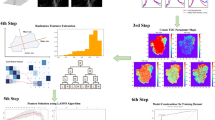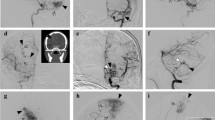Abstract
Seizures are the second most common manifestations of brain arteriovenous malformations (bAVMs). This study was conducted to investigate the clinical and angioarchitectural features of bAVMs with seizures and provide guidelines for the clinical management of these patients. We collected clinical and radiological data on patients with bAVMs diagnosed by digital subtraction angiography between January 2013 and December 2020 and dichotomized the patients into the seizures and non-seizures groups. We identified differences in demographic and angiographic features. Logistic regression and random forest (RF) models were developed and compared. The diagnostic capacity was assessed using receiver operating characteristic (ROC) curves. A nomogram was constructed, and the clinical impact was determined by decision curve analysis. A total of 414 patients with bAVMs were included in the analysis, of which 78 (18.8%) had bAVM-related seizures. In the multivariable logistic regression model, the location and side of bAVMs were independently associated with seizures. In RF models, the maximal diameter of veins and the cross-sectional area of feeding arteries and draining veins were the most important features. ROC curves showed that the RF model was not better than MLR in predicting seizures. Decision curve analysis revealed that the use of a constructed nomogram to stratify the seizure patients was beneficial at all threshold probabilities in our study. The side and location of bAVMs are specific angioarchitectural features independently associated with the occurrences of seizures with bAVMs.




Similar content being viewed by others
Data availability
The original contributions presented in the study are included in the article/supplementary material. Further inquiries can be directed to the corresponding authors.
Code availability
Not applicable.
References
Angus-Leppan H, Clay TA (2021) Adult occipital lobe epilepsy: 12-years on. J Neurol 268:3926–3934
Austin PC, Tu JV, Ho JE, Levy D, Lee DS (2013) Using methods from the data-mining and machine-learning literature for disease classification and prediction: a case study examining classification of heart failure subtypes. J Clin Epidemiol 66:398–407
Benson JC, Chiu S, Flemming K, Nasr DM, Lanzino G, Brinjikji W (2020) MR characteristics of unruptured intracranial arteriovenous malformations associated with seizure as initial clinical presentation. J Neurointerv Surg 12:186–191
Brusko GD, Kolcun JPG, Wang MY (2018) Machine-learning models: the future of predictive analytics in neurosurgery. Neurosurgery 83:E3–E4
Chen CJ, Ding D, Derdeyn CP, Lanzino G, Friedlander RM, Southerland AM et al (2020) Brain arteriovenous malformations: a review of natural history, pathobiology, and interventions. Neurology 95:917–927
Christodoulou E, Ma J, Collins GS, Steyerberg EW, Verbakel JY, Van Calster B (2019) A systematic review shows no performance benefit of machine learning over logistic regression for clinical prediction models. J Clin Epidemiol 110:12–22
De Herdt V, Dumont F, Hénon H, Derambure P, Vonck K, Leys D et al (2011) Early seizures in intracerebral hemorrhage: incidence, associated factors, and outcome. Neurology 77:1794–1800
Delev D, Pavlova A, Grote A, Boström A, Höllig A, Schramm J et al (2017) NOTCH4 gene polymorphisms as potential risk factors for brain arteriovenous malformation development and hemorrhagic presentation. J Neurosurg 126:1552–1559
Della PGM, Parente P, D’Argento F, Pedicelli A, Sturiale CL, Sabatino G et al (2017) Angio-architectural features of high-grade intracranial dural arteriovenous fistulas: correlation with aggressive clinical presentation and hemorrhagic risk. Neurosurgery 81:315–330
Derdeyn CP, Zipfel GJ, Albuquerque FC, Cooke DL, Feldmann E, Sheehan JP et al (2017) Management of brain arteriovenous malformations: a scientific statement for healthcare professionals from the American Heart Association/American Stroke Association. Stroke 48:e200–e224
Fennell VS, Martirosyan NL, Atwal GS, Kalani MYS, Ponce FA, Lemole GM Jr et al (2018) Hemodynamics associated with intracerebral arteriovenous malformations: the effects of treatment modalities. Neurosurgery 83:611–621
Fierstra J, Conklin J, Krings T, Slessarev M, Han JS, Fisher JA et al (2011) Impaired peri-nidal cerebrovascular reserve in seizure patients with brain arteriovenous malformations. Brain 134:100–109
Galletti F, Costa C, Cupini LM, Eusebi P, Hamam M, Caputo N et al (2014) Brain arteriovenous malformations and seizures: an Italian study. J Neurol Neurosurg Psychiatry 85:284–288
Garcin B, Houdart E, Porcher R, Manchon E, Saint-Maurice JP, Bresson D et al (2012) Epileptic seizures at initial presentation in patients with brain arteriovenous malformation. Neurology 78:626–631
Graffeo CS, Sahgal A, De Salles A, Fariselli L, Levivier M, Ma L et al (2020) Stereotactic radiosurgery for Spetzler-Martin grade I and II arteriovenous malformations: International Society of Stereotactic Radiosurgery (ISRS) Practice Guideline. Neurosurgery 87:442–452
Hirano T, Enatsu R, Iihoshi S, Mikami T, Honma T, Ohnishi H et al (2019) Effects of hemosiderosis on epilepsy following subarachnoid hemorrhage. Neurol Med Chir (Tokyo) 59:27–32
Hoh BL, Chapman PH, Loeffler JS, Carter BS, Ogilvy CS (2002) Results of multimodality treatment for 141 patients with brain arteriovenous malformations and seizures: factors associated with seizure incidence and seizure outcomes. Neurosurgery 51:303–309; discussion 309–311.
Holmes MD, Dodrill CB, Kutsy RL, Ojemann GA, Miller JW (2001) Is the left cerebral hemisphere more prone to epileptogenesis than the right? Epileptic Disord 3:137–141
Jiang P, Lv X, Wu Z, Li Y, Jiang C, Yang X et al (2011) Characteristics of brain arteriovenous malformations presenting with seizures without acute or remote hemorrhage. Neuroradiol J 24:886–888
Josephson CB, Leach JP, Duncan R, Roberts RC, Counsell CE, Al-Shahi SR (2011) Seizure risk from cavernous or arteriovenous malformations: prospective population-based study. Neurology 76:1548–1554
Kemmotsu N, Girard HM, Bernhardt BC, Bonilha L, Lin JJ, Tecoma ES et al (2011) MRI analysis in temporal lobe epilepsy: cortical thinning and white matter disruptions are related to side of seizure onset. Epilepsia 52:2257–2266
Lawton MT, Rutledge WC, Kim H, Stapf C, Whitehead KJ, Li DY et al (2015) Brain arteriovenous malformations. Nat Rev Dis Primers 1:15008. https://doi.org/10.1038/nrdp.2015.8
Moftakhar P, Hauptman JS, Malkasian D, Martin NA (2009) Cerebral arteriovenous malformations Part 2 physiology. Neurosurg Focus 26:E11
Morgan MK, Davidson AS, Assaad NNA, Stoodley MA (2017) Critical review of brain AVM surgery, surgical results and natural history in 2017. Acta Neurochir (Wien) 159:1457–1478
Ndode-Ekane XE, Hayward N, Gröhn O, Pitkänen A (2010) Vascular changes in epilepsy: functional consequences and association with network plasticity in pilocarpine-induced experimental epilepsy. Neuroscience 166:312–332
Pietrafusa N, de Palma L, De Benedictis A, Trivisano M, Marras CE, Vigevano F et al (2015) Ictal vomiting as a sign of temporal lobe epilepsy confirmed by stereo-EEG and surgical outcome. Epilepsy Behav 53:112–116
Pohjola A, Oulasvirta E, Roine RP, Sintonen HP, Hafez A, Koroknay-Pál P et al (2019) Long-term health-related quality of life in 262 patients with brain arteriovenous malformation. Neurology 93:e1374–e1384
Santos ML, Demartini JZ, Matos LA, Spotti AR, Tognola WA, Sousa AA et al (2009) Angioarchitecture and clinical presentation of brain arteriovenous malformations. Arq Neuropsiquiatr 67:316–321
Senders JT, Staples PC, Karhade AV, Zaki MM, Gormley WB, Broekman MLD et al (2018) Machine learning and neurosurgical outcome prediction: a systematic review. World Neurosurg 109:476-486.e471
Shankar JJ, Menezes RJ, Pohlmann-Eden B, Wallace C, TerBrugge K, Krings T (2013) Angioarchitecture of brain AVM determines the presentation with seizures: proposed scoring system. AJNR Am J Neuroradiol 34:1028–1034
Soldozy S, Norat P, Elsarrag M, Chatrath A, Costello JS, Sokolowski JD et al (2019) The biophysical role of hemodynamics in the pathogenesis of cerebral aneurysm formation and rupture. Neurosurg Focus 47:E11
Solomon RA, Connolly ES Jr (2017) Arteriovenous malformations of the brain. N Engl J Med 376:1859–1866
Spetzler RF, Martin NA (1986) A proposed grading system for arteriovenous malformations. J Neurosurg 65:476–483
Strobl C, Boulesteix AL, Zeileis A, Hothorn T (2007) Bias in random forest variable importance measures: illustrations, sources and a solution. BMC Bioinformatics 8:25
Sturiale CL, Rigante L, Puca A, Di Lella G, Albanese A, Marchese E et al (2013) Angioarchitectural features of brain arteriovenous malformations associated with seizures: a single center retrospective series. Eur J Neurol 20:849–855
Swets JA (1988) Measuring the accuracy of diagnostic systems. Science 240:1285–1293
Turjman F, Massoud TF, Sayre JW, Viñuela F, Guglielmi G, Duckwiler G (1995) Epilepsy associated with cerebral arteriovenous malformations: a multivariate analysis of angioarchitectural characteristics. AJNR Am J Neuroradiol 16:345–350
van Lanen RH, Melchers S, Hoogland G, Schijns OE, Zandvoort MAV, Haeren RH et al (2021) Microvascular changes associated with epilepsy: a narrative review. J Cereb Blood Flow Metab 41:2492–2509
Vickers AJ, Elkin EB (2006) Decision curve analysis: a novel method for evaluating prediction models. Med Decis Making 26:565–574
Williamson A, Patrylo PR, Lee S, Spencer DD (2003) Physiology of human cortical neurons adjacent to cavernous malformations and tumors. Epilepsia 44:1413–1419. https://doi.org/10.1046/j.1528-1157.2003.23603.x
Zhang Y, Zhang B, Liang F, Liang S, Zhang Y, Yan P et al (2019) Radiomics features on non-contrast-enhanced CT scan can precisely classify AVM-related hematomas from other spontaneous intraparenchymal hematoma types. Eur Radiol 29:2157–2165
Funding
This study has received funding by grants from the National Natural Science Foundation of China (Grant Number 81873756).
Author information
Authors and Affiliations
Contributions
Langchao Yan: study concept and design, acquisition of data, statistical analysis, interpretation of data; Wengui Tao and Zheng Huang: acquisition and analysis of data; Qian Zhang: analysis and interpretation of data, critical revision of manuscript; Fenghua Chen and Shifu Li: study concept and design, study supervision.
Corresponding author
Ethics declarations
Ethics approval
All procedures in this study that involved human participants were approved by the ethics committee of our hospital and were performed in accordance with the standards of institutional ethics, the 1964 Declaration of Helsinki, and its later amendments, or comparable ethical standards.
Consent to participate
Informed consent was obtained from all individual participants with normal neurological status or by relatives in all other cases.
Consent for publication
The authors agreed this publication.
Conflict of interest
The authors declare no competing interests.
Additional information
Publisher's note
Springer Nature remains neutral with regard to jurisdictional claims in published maps and institutional affiliations.
Supplementary Information
Below is the link to the electronic supplementary material.
Rights and permissions
About this article
Cite this article
Yan, L., Tao, W., Zhan, Q. et al. Angioarchitectural features of brain arteriovenous malformation presented with seizures. Neurosurg Rev 45, 2909–2918 (2022). https://doi.org/10.1007/s10143-022-01814-3
Received:
Revised:
Accepted:
Published:
Issue Date:
DOI: https://doi.org/10.1007/s10143-022-01814-3




